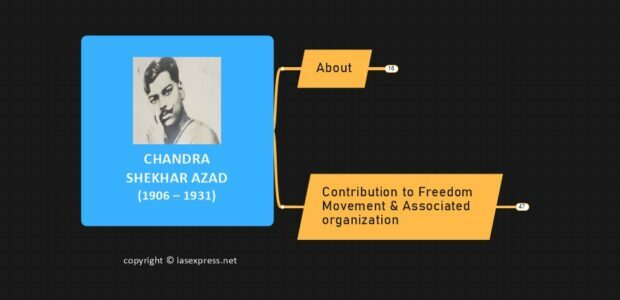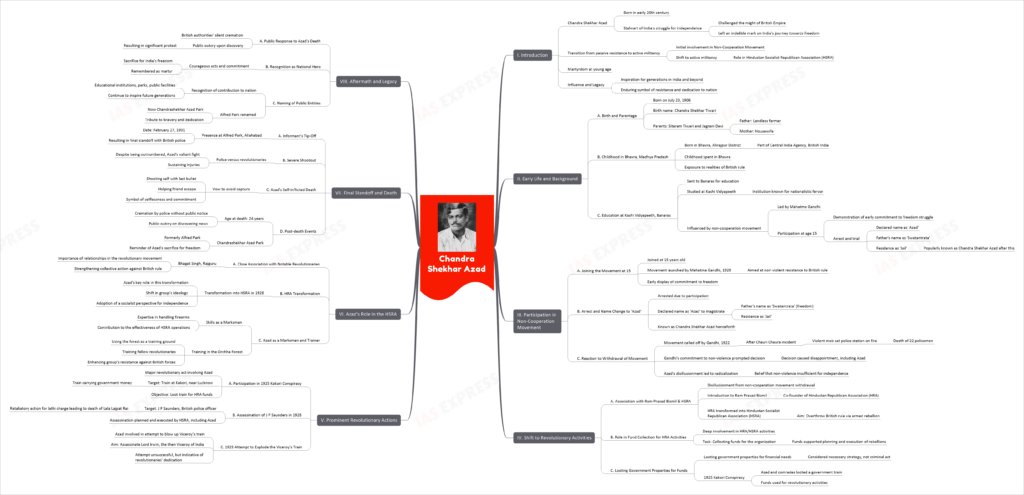Chandra Shekhar Azad (1906-1931) – Biography, Contributions, Legacy

This topic of “Chandra Shekhar Azad (1906-1931) – Biography, Contributions, Legacy” is important from the perspective of the UPSC IAS Examination, which falls under General Studies Portion.
I. Introduction
Chandra Shekhar Azad, a stalwart of India’s struggle for independence, was a man of unyielding spirit and profound patriotism. Born in the early 20th century, Azad courageously challenged the might of the British Empire, leaving an indelible mark on India’s journey towards freedom. His life, marked by a bold shift from passive resistance during the non-cooperation movement to active militancy, and his martyrdom at a young age have continued to inspire generations in India and beyond, making him an enduring symbol of resistance and dedication to one’s nation.
II. Early Life and Background
A. Azad’s Birth and Parents
- Chandra Shekhar Azad was born on July 23, 1906.
- His birth name was Chandra Shekhar Tiwari.
- His parents were Sitaram Tiwari and Jagrani Devi.
- His father, Sitaram Tiwari, was a poor, landless farmer, and his mother, Jagrani Devi, was a housewife.
B. His Early Life in Bhavra, Alirajpur District, Madhya Pradesh
- He was born in Bhavra, a small village in the Alirajpur District of Madhya Pradesh, which was then part of the Central India Agency, British India.
- He spent his early years in this village.
- His family was not wealthy but they ensured he had a good upbringing.
- Growing up, Azad was exposed to the harsh realities of British rule, shaping his revolutionary spirit.
C. His Education at the Kashi Vidyapeeth in Banaras
- Azad was sent to Banaras (now Varanasi) for his education.
- He studied at the Kashi Vidyapeeth, an institution known for its nationalistic fervor.
- During his time in Banaras, he was deeply influenced by the non-cooperation movement started by Mahatma Gandhi.
III. Involvement in the Non-Cooperation Movement
A. Azad’s Joining of the Movement at Age 15
- At the young age of 15, Chandra Shekhar Azad joined the non-cooperation movement.
- This movement was launched by Mahatma Gandhi in 1920, aiming to resist British rule in India through non-violent means.
- Azad’s participation in this movement demonstrated his early resolve and commitment to the cause of India’s freedom.
B. His Arrest and the Adoption of the Name ‘Azad’
- As a result of his participation in the movement, Azad was arrested by the British authorities.
- When produced before the magistrate, he defiantly announced his name as ‘Azad’, his father’s name as ‘Swatantrata’ (freedom), and his place of dwelling as ‘Jail’.
- This act of rebellion marked a turning point in his life, and he became known as Chandra Shekhar Azad from then on.
C. The Withdrawal of the Movement by Gandhi and Azad’s Disappointment
- The non-cooperation movement was abruptly called off by Mahatma Gandhi in 1922 after the Chauri Chaura incident, where a violent mob set a police station on fire leading to the death of 22 policemen.
- Gandhi’s decision was driven by his commitment to non-violence. However, it led to a great deal of disappointment among many of the movement’s followers, including Azad.
- Feeling disillusioned by the sudden end of the movement, Azad grew more radical in his approach towards achieving independence. He believed that the non-violent method was not enough to obtain freedom from British rule.
IV. Transition to Revolutionary Activities
A. Azad’s Association with Ram Prasad Bismil and the Hindustan Socialist Republican Association (HSRA)
- Disappointed by the withdrawal of the non-cooperation movement, Azad moved towards a more radical approach to the freedom struggle.
- He became acquainted with Ram Prasad Bismil, who was one of the founders of the Hindustan Republican Association (HRA), which later became the Hindustan Socialist Republican Association (HSRA).
- The HRA/HSRA was a revolutionary organization aiming to overthrow the British rule in India through armed rebellion.
B. His Involvement in Collecting Funds for HRA’s Activities
- Azad became deeply involved in the activities of the HRA/HSRA.
- He took up the task of collecting funds to support the organization’s revolutionary activities, which included planning and executing acts of rebellion against the British government.
C. The Looting of Government Properties to Fund Revolutionary Activities
- To meet the financial needs of the HRA/HSRA, Azad and his fellow revolutionaries began looting government properties.
- This was not seen as a criminal act by the revolutionaries, but as a necessary strategy to fund their struggle for independence.
- One notable instance of such an act was the 1925 Kakori Conspiracy, where Azad and his comrades looted a government train to fund their revolutionary activities.
V. Major Revolutionary Acts
A. Azad’s Involvement in the 1925 Kakori Conspiracy
- The 1925 Kakori Conspiracy was a major revolutionary act involving Azad.
- Along with other revolutionaries, Azad targeted a train at Kakori, near Lucknow, which was carrying government money.
- The aim was to loot the train to gather funds for the Hindustan Republican Association’s activities.
B. The Shooting of J P Saunders in 1928
- In 1928, Azad was involved in the assassination of J P Saunders, a British police officer.
- Saunders was targeted in retaliation for the lathi charge he led that caused the death of prominent Indian nationalist leader Lala Lajpat Rai.
- The assassination was planned and executed by the Hindustan Socialist Republican Association, which Azad was a part of.
C. The 1929 Attempt to Blow Up the Viceroy’s Train
- Another significant act Azad was involved in was the 1929 attempt to blow up the Viceroy’s train.
- The goal of this act was to assassinate Lord Irwin, the then Viceroy of India.
- Although the attempt was unsuccessful, it was a clear indication of the lengths the revolutionaries, including Azad, were willing to go to in their fight against British rule.
VI. Azad’s Role in the HSRA
A. His Close Association with Bhagat Singh, Rajguru, and Other Revolutionaries
- Azad had a close association with notable revolutionaries such as Bhagat Singh and Rajguru.
- These relationships were a fundamental part of the revolutionary movement, strengthening its resolve and collective action against British rule.
B. The Transformation of the HRA into the HSRA in 1928
- In 1928, Azad played a key role in the transformation of the Hindustan Republican Association (HRA) into the Hindustan Socialist Republican Association (HSRA).
- This transformation was reflective of the shift in the group’s ideology towards a more socialist perspective in their fight for independence.
C. Azad’s Skills as a Marksman and His Training of Other Revolutionaries in the Orchha Forest
- Azad was not only a key participant in revolutionary activities but also a skilled marksman.
- His expertise in handling firearms was instrumental in the effectiveness of the HSRA’s operations.
- He used the Orchha forest as a training ground where he trained fellow revolutionaries, further enhancing the group’s ability to resist British forces.
VII. The Final Standoff and Death
A. The Informant’s Tip-Off to The Police About Azad’s Presence at Alfred Park in Allahabad
- On February 27, 1931, an informant tipped off the police about Azad’s presence at Alfred Park in Allahabad.
- This information led to the final standoff between Azad and the British police, marking the end of Azad’s revolutionary journey.
B. The Ensuing Shootout Between the Police and the Revolutionaries
- Upon receiving the tip, the police arrived at the park leading to a severe shootout between the police and the revolutionaries.
- Azad, despite being outnumbered, fought valiantly against the police, sustaining injuries in the process.
C. Azad’s Decision to Take His Own Life Rather Than Being Captured
- Azad had made a vow to never be captured alive by the British. Staying true to his resolve, he shot himself with his last bullet when he realized he could not escape.
- His sacrifice allowed his friend to escape from the scene, demonstrating his selflessness and commitment to the cause till his last breath.
- Azad was only 24 years old at the time of his death. His body was cremated by the police without any public notice, leading to a significant public outcry when the news was discovered.
- Today, Alfred Park is known as Chandrashekhar Azad Park, serving as a permanent reminder of his sacrifice for the nation’s freedom.
VIII. Aftermath and Legacy
A. The Public’s Reaction to Azad’s Death
- Azad’s death was followed by a significant public outcry. The British authorities tried to keep his death quiet, cremating his body without informing the public.
- However, when the public came to know about the incident, it sparked a big protest, reflecting the admiration and respect Azad had garnered among the Indian populace.
B. Azad’s Status as a National Hero and Martyr for the Cause of India’s Freedom
- Azad’s courageous acts, steadfast commitment to the cause, and ultimate sacrifice have cemented his status as a national hero.
- Even today, he is remembered as a martyr for the cause of India’s freedom, revered for his unwavering spirit and his contribution to the independence struggle.
C. The Naming of Public Institutes and Places After Him
- In recognition of his contribution to the nation, several public institutes and places have been named after Chandra Shekhar Azad.
- These include educational institutions, parks, and other public facilities, ensuring that his name continues to inspire future generations.
- A significant example is Alfred Park in Allahabad, where his last battle took place, which has been renamed Chandrashekhar Azad Park. It stands as a tribute to his bravery and dedication to India’s freedom.
IX. Conclusion
Chandra Shekhar Azad, an unyielding freedom fighter, played a pivotal role in India’s struggle for independence. From his early involvement with the Non-Cooperation Movement to his revolutionary actions under the Hindustan Socialist Republican Association, his life was marked by unwavering commitment and audacity. His strategic foresight, seen in major revolutionary acts, and his resolve, demonstrated in his final act, continue to inspire millions. Today, his legacy lives on as a national hero, etched in the collective memory of India.


